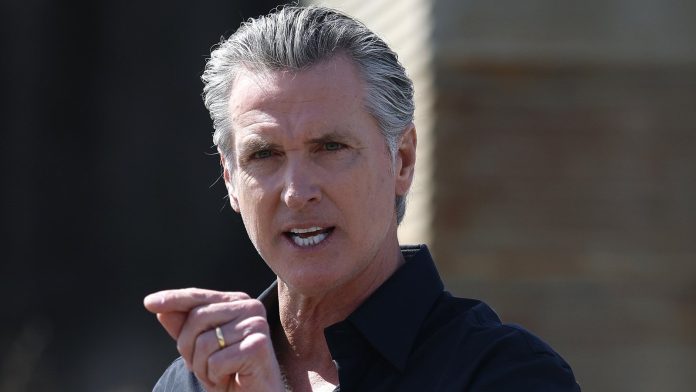
California’s Bold Stand Against Gerrymandering: A Fight for Democracy’s Soul
In the heart of Los Angeles, beneath the vibrant skylines and the cultural mosaic of Little Tokyo, California Governor Gavin Newsom made a declaration that crackled with defiance and determination.
With a sharp glint in his eye and the emblematic bear of the Golden State glowing behind him, Newsom unveiled a daring plan to redraw California’s electoral districts — a direct counterpunch to what Democrats decry as a brazen attempt by former President Donald Trump and his allies to rig next year’s congressional elections.
“Today is Liberation Day in the State of California,” Newsom proclaimed, his voice echoing through the Democracy Center, a symbolic venue for this battle over the very essence of democracy. “Donald Trump, you have poked the bear, and we will punch back.”
The Stakes: More Than Just Lines on a Map
On its surface, redrawing electoral districts might seem like a mundane bureaucratic task, but beneath it lies a powerful tool that shapes the voices heard in Congress and the direction the nation takes. Every decade, after the national census counts the population, states redraw the boundaries of their Congressional districts to ensure fair representation. But the process is vulnerable to manipulation. Gerrymandering — the deliberate carving of districts to favor one party — has long been a weapon wielded by political strategists hungry for power.
In Texas, GOP Governor Greg Abbott, at the urging of Trump, has embarked on a mid-decade effort to reshape the state’s districts — a move that flies in the face of the usual ten-year cycle and arguably violates the spirit of fair representation. The goal? To snatch a handful of districts and fortify the Republican hold on the House of Representatives ahead of the 2024 mid-term elections.
“It’s essentially a play to tilt the scales,” explains Dr. Maria Vasquez, a political scientist specializing in electoral integrity at UCLA. “Mid-decade redistricting isn’t just rare — it’s destabilizing. It undermines the principles of democracy by preemptively scripting who gets to wield power.”
Texas Democrats have made a dramatic stand, with dozens fleeing the state in an effort to deny Republicans the quorum needed to pass the controversial maps. Armed with threats of arrest and stern warnings, the political drama plays out like a high-stakes chess match — one where the rules are both weaponized and contested.
California’s Counterstrike: Democracy Ballots and Independence
Against this backdrop, California’s approach is both innovative and fiercely principled. Governor Newsom announced that voters will face a special ballot on November 4, one that asks them to approve temporary congressional maps for the next two elections. Following this period, the reins will return to an independent commission, insulating the process from direct partisan influence.
“We’re doing this in response to a president of the United States who calls a sitting governor of Texas and says, ‘Find me five seats,’” Newsom said, a sharp rebuke filled with palpable frustration. “He’s trying to rig the system. He doesn’t play by a different set of rules; he doesn’t believe in the rules.”
For those watching this clash unfold on a national stage, California’s gambit is a powerful symbol of resistance. The state’s 39 million residents, one of the world’s largest economies and cultural powerhouses, are mobilizing to stand against a tide they view as deeply corrosive to democratic fairness.
Behind the Headlines: A Battle of Values and Visions
The rivalry between Newsom and Trump is as much personal as it is political. Their feuds ripple far beyond redistricting battles — spanning immigration policies, public protests, and visions of America’s identity. Last June, for example, when masked agents conducted sweeping immigration raids across Los Angeles, the city erupted in outrage. Trump’s response was to deploy the National Guard and Marines under the banner of restoring order, a heavy-handed move that only deepened divisions.
Locals recall the tension vividly. Maria Torres, a community organizer in East LA, described the raids as “a moment of fear and resilience.” “Families were terrified, unsure who would be next,” she said. “But the community came together — we told those agents, ‘This is our home. This is our fight.’”
Against this charged atmosphere, Newsom’s mockery of Trump’s signature bluster felt like a strategic flourish. Through a series of social media posts dripping with parody — all caps, playful nicknames, and tongue-in-cheek threats — Newsom wielded humor to undermine Trump’s looming shadow. “I, Gavin Christopher Newsom, America’s favorite governor (many say), will host the greatest press conference of all time,” he tweeted, poking fun while rallying supporters.
Why Should We Care? The Fight for Fair Representation Is a Global Concern
As you read about California’s audacious defense of democracy, it’s worth pondering the broader implications.
- How does the manipulation of electoral boundaries erode trust in institutions, no matter where you are in the world?
- What happens when political power becomes a game of drawing lines rather than earning votes?
- And importantly, how do citizens rise to reclaim their voice when the system seems rigged against them?
Gerrymandering isn’t unique to the United States — from Eastern Europe to Africa, from South America to the Asia-Pacific region, the struggle for fair and transparent elections is universal. The precise maps may differ, but the stakes are global: the vitality of democracy, the legitimacy of governments, and the rights of people to freely choose their representatives.
The Road Ahead: A Test Not Just of Maps but of Democratic Resolve
With millions poised to vote on Newsom’s proposal, November will be a critical battlefield. Should Californians greenlight the temporary districts, they will send a message far beyond their state lines — that democracy isn’t a spectator sport and that citizens demand fairness even amid fierce political contests.
“This is about more than just a few congressional seats,” says Dr. Vasquez. “It’s about who we are as a democracy. The way we draw districts can either reflect our diversity and complexity or distort it into partisan advantage.”
The bear may have been poked, but in California, the beast is awakening. And as the nation and the world watch, one can’t help but ask: in the face of forces that seek to bend democracy toward narrow ends, who will rise? And what price are we all willing to pay to keep the promise of fair representation alive?
For voters in California, the answer will be written not just in ink on ballots but in the very future of American democracy — a future that, in many ways, reflects the enduring global quest for justice, equity, and political integrity.









